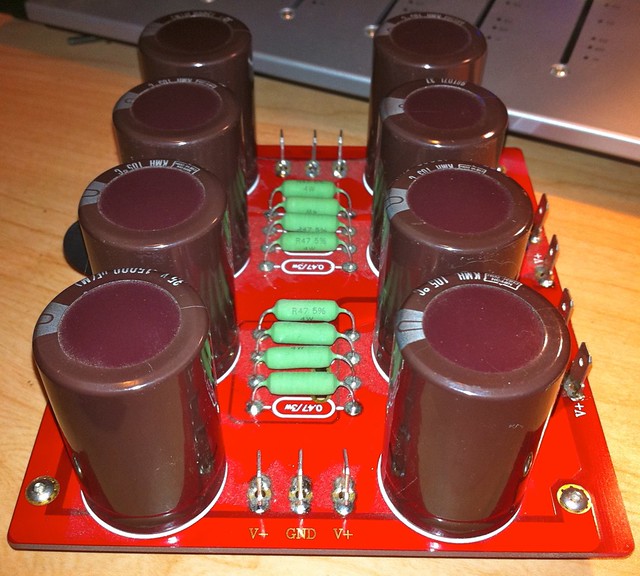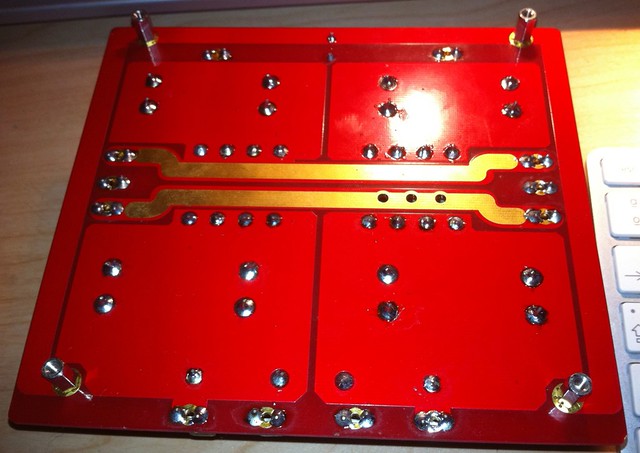So today I found the time to finally finish up my F5 amp. I have been using it with a bench power supply and loving it but I wanted to have the amp complete. I bought my parts from DIYaudio and techDIY with the exception of the PS board. For that I bought from gigaworks on ebay. The main reason I went with it was the fact that everything was included. I have to say the build quality was subpar. Well I got everything together and started listening to the amp. The first thing I notice is that there is much less bass. The bench PS I have is very robust, the gigawork just seemed to be lacking. Well I let it run in a few hours and although everything sounded ok it just didn't sound as nice as my bench PS. So here is where things get a bit scary. I left the room with music playing to do some paperwork. Everything was fine until my girl friend said it sounded like the cat was doing something he shouldn't be in the basement. That moment I smelled burnt circutboard and rushed down. The PS board was on fire!!! I unpluged everything and blew the fire out. It seems that the traces heated up and shorted, the fuse I had did not blow for what ever reason. Everything is ok and only the PS is damaged but let my experience remind you guys that you should always be careful and don't use cheap Chinese parts no matter what your reason.
So today I found the time to finally finish up my F5 amp. I have been using it with a bench power supply and loving it but I wanted to have the amp complete. I bought my parts from DIYaudio and techDIY with the exception of the PS board. For that I bought from gigaworks on ebay. The main reason I went with it was the fact that everything was included. I have to say the build quality was subpar. Well I got everything together and started listening to the amp. The first thing I notice is that there is much less bass. The bench PS I have is very robust, the gigawork just seemed to be lacking. Well I let it run in a few hours and although everything sounded ok it just didn't sound as nice as my bench PS. So here is where things get a bit scary. I left the room with music playing to do some paperwork. Everything was fine until my girl friend said it sounded like the cat was doing something he shouldn't be in the basement. That moment I smelled burnt circutboard and rushed down. The PS board was on fire!!! I unpluged everything and blew the fire out. It seems that the traces heated up and shorted, the fuse I had did not blow for what ever reason. Everything is ok and only the PS is damaged but let my experience remind you guys that you should always be careful and don't use cheap Chinese parts no matter what your reason.
I've had great luck with Chinese parts. I buy with the same care I use for any purchase. Though I considered it, I specifically didn't buy the PS you mentioned because I didn't know the parts. I did buy Chinese PCBs for my first two PS (when I was just starting DIY, now I etch my own) and I bought my parts from well known US suppliers. Those PS are still running.
I've gotten good and bad from every major market, the Chinese market is no different. If you're unsure of a part, ask in the forum, you'll do well.
I'm running the same Gigaworks power supply board--but I increased the cross-section of the +/-/ground rails on the power supply PCB by soldering a bare 16-gauge solid copper "buss" onto the high-current traces, with a continuous solder bead. No problems noted. (Just something to consider, if the power traces look a little wimpy.)
You can get almost the same results just by running a heavy solder bead (without the added copper wire) along each high-current trace
I also swapped out the Gigaworks 10,000 mfd caps with 18,000 mfd ones, purchased from Apex.
You can get almost the same results just by running a heavy solder bead (without the added copper wire) along each high-current trace
I also swapped out the Gigaworks 10,000 mfd caps with 18,000 mfd ones, purchased from Apex.
Curious, I was running my F5 with a similar board (From tubeshunter) more than a year and worked perfect (16 hours at day "on"), the traces are ok (Thick cooper). Now I'm using a identical board with a thicker cooper and gold plated from Jims Audio (More than enough for this current), but with Mundorf and MUR rectifiers and is great.
I don't heard a significative differences between my actual Mundorf board against the cheap 10000uF Rubycons, but I felt a big differente with the MUR instead the square rectifiers.
Maybe a defective serial of boards with a thin cooper.
I don't heard a significative differences between my actual Mundorf board against the cheap 10000uF Rubycons, but I felt a big differente with the MUR instead the square rectifiers.
Maybe a defective serial of boards with a thin cooper.
Well now I need to build a new PS. I am debating trying a jims audio board (which looks much better designed then the gigaworks) or using what I have laying around and wiring point to point. I think part of the problem with the gigaworks was that the V+/- + ground traces were too close together. I was careful not to bridge anything but as the amp heated up anything could of happened.
Any input on using 2 X 63V 22000uf + 2 X 40V 68000UF caps to make a power supply. They just barely fit in the chassis but I would only need some resistors or if I could fit them 2 chokes and I would have a power supply (I think, LOL). I am still very new to amps and although I think I get parts if it I still have doubts.
Any input on using 2 X 63V 22000uf + 2 X 40V 68000UF caps to make a power supply. They just barely fit in the chassis but I would only need some resistors or if I could fit them 2 chokes and I would have a power supply (I think, LOL). I am still very new to amps and although I think I get parts if it I still have doubts.
Last edited:
Some people may not know where to look for Peter's PSU boards, here's a link.
http://www.diyaudio.com/forums/audio-sector/149672-universal-power-supply-pcb.html
http://www.diyaudio.com/forums/audio-sector/149672-universal-power-supply-pcb.html
It seems that the traces heated up and shorted.
DJNUBZ...... I'm trying to better understand the "failure mode" of your power supply. You say the traces heated up and shorted. I can understand the traces (perhaps) getting warm with a very high current load (typically more than the F5 would require), but can you explain the "shorted" comment? All the PCBs I've seen for these amp's power supplies (Jim's Audio, Peter Daniels, Gigaworks, etc) seem to have about the same "buss spacing", so I don't understand why you saw shorted traces....where, in particular? Was the PCB substraight (the fiberglass itself) on fire?
Just curious..... trying to better understand how your power supply failed.
Well now I need to build a new PS. I am debating trying a jims audio board (which looks much better designed then the gigaworks) or using what I have laying around and wiring point to point. I think part of the problem with the gigaworks was that the V+/- + ground traces were too close together. I was careful not to bridge anything but as the amp heated up anything could of happened.
Any input on using 2 X 63V 22000uf + 2 X 40V 68000UF caps to make a power supply. They just barely fit in the chassis but I would only need some resistors or if I could fit them 2 chokes and I would have a power supply (I think, LOL). I am still very new to amps and although I think I get parts if it I still have doubts.
My first builds were with Jim's PS boards and Apex Jr's Panasonic 18000uF 50V caps for $2.50 each. The result was great.
DJNUBZ...... I'm trying to better understand the "failure mode" of your power supply. You say the traces heated up and shorted. QUOTE]
Re; My earlier post, partially quoted above. Any info to share with us?
Something else to consider. The PSU filter resistors (the "R" in CRC) can run warm in these amps. Don't know how you mounted yours, but it's best to mount them "up" and away from the board, so that there is some airflow under the resistors. When I mount such power resistors, I place a temporary shim under the resistor (a paint stirring stick, narrowed down to the length of the resistor works fine). This will "space" the resistor away from the board, while you solder it in place. Afterwards slide the shim out from under the resistor. Also works nicely when mounting multiple resistors, since it maintains the same "spacing from the board" for each resistor--nice, uniform and neat fabrication. 'Don't know if this was part of your problem, but if it was, I hope this helps.
I will try to post pics of what went wrong when I get a chance.
I think I am going to try using the caps I have on hand to make a PS. The Jim's boards and Peter's boards look like better boards and will probably use them on my next project. For now I think I will use the caps I listed because I know they will fit in my chassis, unless there is a reason not to.
I think I am going to try using the caps I have on hand to make a PS. The Jim's boards and Peter's boards look like better boards and will probably use them on my next project. For now I think I will use the caps I listed because I know they will fit in my chassis, unless there is a reason not to.
- Status
- This old topic is closed. If you want to reopen this topic, contact a moderator using the "Report Post" button.
- Home
- Amplifiers
- Pass Labs
- A Cautionary Tale


